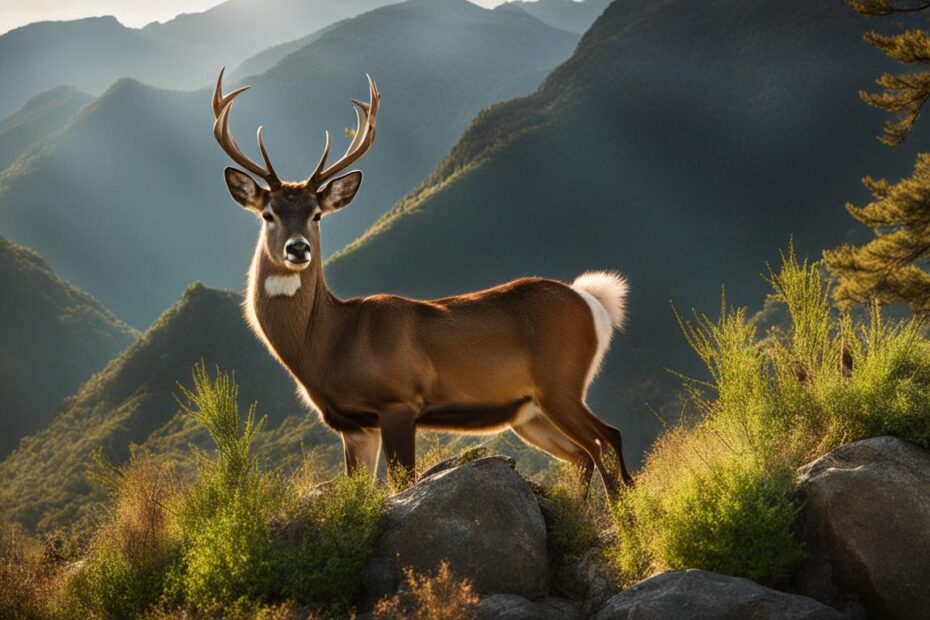Welcome to this intriguing exploration of the differences and similarities between deer and goats. These magnificent creatures embody the diversity of nature and captivate us with their unique characteristics. By delving into the fascinating world of deer and goats, we can gain a deeper understanding of their distinct traits and appreciate the wonders they bring to our natural landscape.
Key Takeaways:
- Deer and goats have distinct dietary preferences and nutritional needs.
- Physical characteristics such as size, antlers, and horns differ between deer and goats.
- Both deer and goats exhibit social behavior and have unique herd dynamics.
- Reproduction and offspring characteristics vary between deer and goats.
- Deer and goats have significant economic and agricultural importance.
The Diet and Nutritional Needs of Deer and Goats
Understanding the diet and nutritional needs of deer and goats is essential for their health and well-being. While both are herbivores, their feeding habits and dietary requirements differ significantly.
Diet of Deer:
Deer are primarily grazers and consume a variety of plant matter, including grass, leaves, and shoots. Their diet is rich in fiber and low in protein. To meet their nutritional needs, deer rely on a consistent and plentiful supply of vegetation.
Diet of Goats:
Goats, on the other hand, are browsers and have a more diverse diet. They consume a range of vegetation, including leaves, twigs, and shrubs. Goats have a higher tolerance for plant toxins and can even eat certain poisonous plants. Their diet requires a higher protein content compared to deer.
Nutritional Needs of Deer and Goats:
Deer and goats have distinct nutritional needs based on their feeding habits. Deer require a high-fiber diet to support their digestive system, while goats need a diet with higher protein content for optimal growth and health.
Overall, understanding the diet and nutritional needs of deer and goats is crucial for their overall well-being and should be taken into consideration when managing their care and habitat.
Physical Characteristics of Deer and Goats
In this section, we will explore the physical characteristics of deer and goats, highlighting their size, antlers, and horns. Understanding these distinct features will provide insights into their unique attributes and adaptations.
Size
When it comes to size, deer are generally larger than goats. Deer typically stand 3 to 4 feet tall at the shoulder, with some species reaching even greater heights. In comparison, goats are generally smaller, averaging around 2 to 3 feet in height at the shoulder. However, it is important to note that there is significant variation in size among different deer and goat species.
Antlers of Deer
One prominent feature of deer is their antlers. Antlers are unique to the deer family and are primarily found in male deer known as bucks. Antlers are branched structures that grow and are shed and regrown annually. They are composed of bone and are covered with a layer of velvet during their growth phase. The size and shape of antlers can vary depending on the species and age of the deer.
Horns of Goats
Unlike deer, goats have horns instead of antlers. Horns are present in both male and female goats and tend to be permanent structures. They are made of keratin, the same material as our hair and nails, and continue to grow throughout the goat’s life. Goat horns vary in shape and size, with some goat species having long, curved horns, while others have shorter and straighter horns.
| Deer | Goats | |
|---|---|---|
| Average Size | Taller, 3-4 feet at the shoulder | Shorter, 2-3 feet at the shoulder |
| Antlers/Horns | Antlers found in male deer | Horns found in both male and female goats |
| Growth | Antlers shed and regrown annually | Horns continue to grow throughout the goat’s life |
“The size and shape of antlers can vary depending on the species and age of the deer.” – Wildlife Expert
These physical characteristics of deer and goats showcase the fascinating diversity in nature. While deer exhibit impressive antlers that are shed and regrown, goats possess permanent horns. Understanding these distinctions enhances our appreciation for the beauty and adaptations of these remarkable creatures.
Social Behavior and Herd Dynamics
Understanding the social behavior and herd dynamics of deer and goats provides valuable insights into their fascinating lives. Both species exhibit complex social structures and engage in unique behaviors during mating seasons. Let’s explore the social dynamics of deer and goats in more detail.
Behavior of Deer:
Deer are social animals that typically form small groups or herds, especially during the mating season. These herds consist of females, called does, and their offspring, while adult males, known as bucks, may establish territories and compete for mates. During the mating season, bucks use vocalizations and physical displays, such as antler displays, to attract females. This period is marked by heightened activity and social interactions among deer herds, as they navigate the complexities of courtship and reproduction.
Behavior of Goats:
Goats also exhibit social behavior and have a hierarchical social structure within their herds. They form tightly knit groups, typically led by a dominant male, known as a buck or a billy, and several females, known as does or nannies. Communication among goats is an essential aspect of their social interactions, especially during the mating season. Male goats use vocalizations, such as bleating, and physical displays, such as headbutting, to establish dominance and attract potential mates. Female goats may display receptive behaviors, indicating their willingness to mate, and engage in vocalizations to communicate within the herd.
The mating season for deer and goats typically occurs at distinct times of the year, depending on the species and geographical location. These periods of increased social activity and reproductive behaviors play a vital role in the perpetuation of their respective populations.
| Social Behavior of Deer | Social Behavior of Goats | |
|---|---|---|
| Mating Season | Varies depending on species and location; typically marked by increased activity and vocalizations by bucks | Varies depending on species and location; characterized by dominant male displays and receptive behaviors by females |
| Herd Structure | Small groups or herds consisting of does and their offspring; adult males may establish territories | Tightly knit herds with a dominant male (buck or billy) and several females (does or nannies) |
| Hierarchy | Minimal hierarchy within herds, with dominant males competing for mates | Dominant male leads the herd, establishing hierarchy through displays and physical interactions |
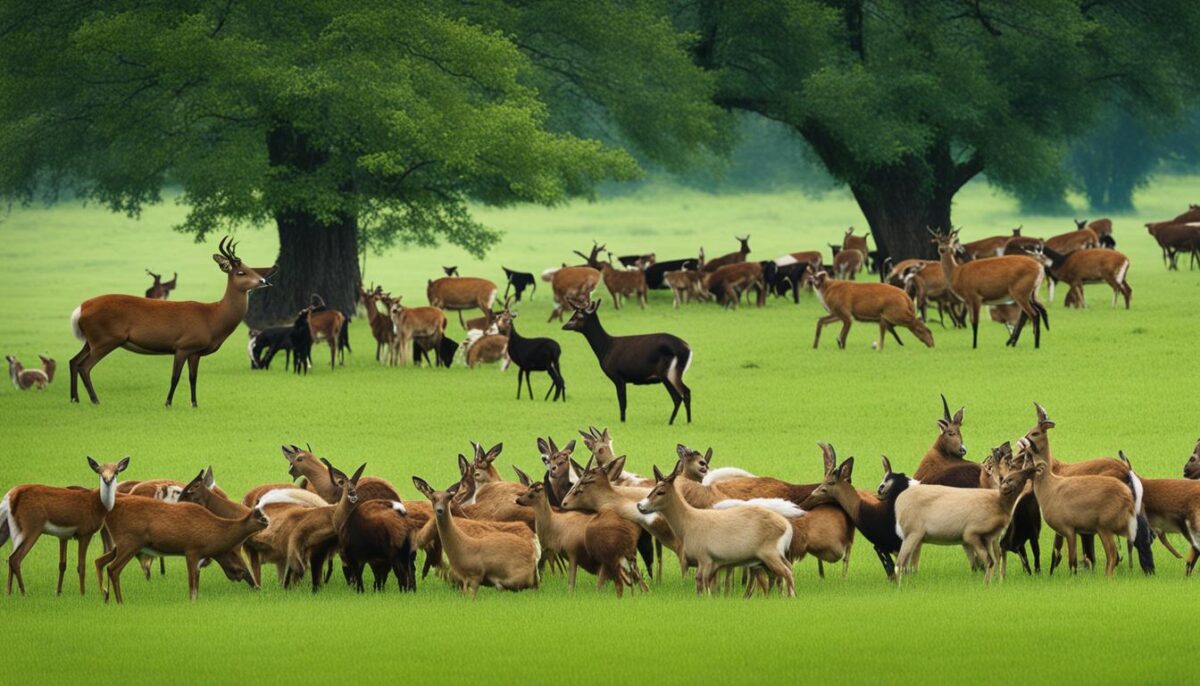
“Mating seasons are significant periods for both deer and goats, as they engage in distinct social behaviors and dynamic interactions within their herds. Understanding their social structures and behaviors enhances our appreciation for the complexities of their lives.”
Reproduction and Offspring
Understanding the reproductive behaviors and offspring characteristics of deer and goats provides valuable insights into their life cycles. The reproduction of deer and goats showcases interesting differences that contribute to their respective populations.
Female deer, known as does, have a gestation period of around 6-7 months. They typically give birth to a single fawn at a time. The fawn is born with a spotted coat that provides camouflage and protection. This solitary birth pattern allows the doe to focus her energy and resources on the survival of the individual offspring.
On the other hand, female goats, called does, have a shorter gestation period of about 5 months. They can give birth to multiple offspring, usually 1-3 kids at a time. Goat kids are known for their playful behavior and are able to walk shortly after birth. This reproductive strategy allows goats to produce a higher number of offspring, increasing their chances of survival in diverse environments.
| Gestation Period | Offspring Quantity | Offspring Behavior | |
|---|---|---|---|
| Deer | 6-7 months | Usually 1 fawn | Spotting coat for camouflage |
| Goats | 5 months | Usually 1-3 kids | Playful behavior and quick mobility |
“The birth strategies of deer and goats showcase fascinating adaptations to their environments. While deer focus on the survival of a single fawn, goats take advantage of their ability to produce multiple kids at once.”
Summary:
- Deer have a gestation period of 6-7 months and typically give birth to a single fawn.
- Goats have a shorter gestation period of 5 months and can give birth to 1-3 kids.
- Deer offspring have a spotted coat for camouflage, while goat kids are known for their playful behavior and quick mobility.
Economic and Agricultural Importance
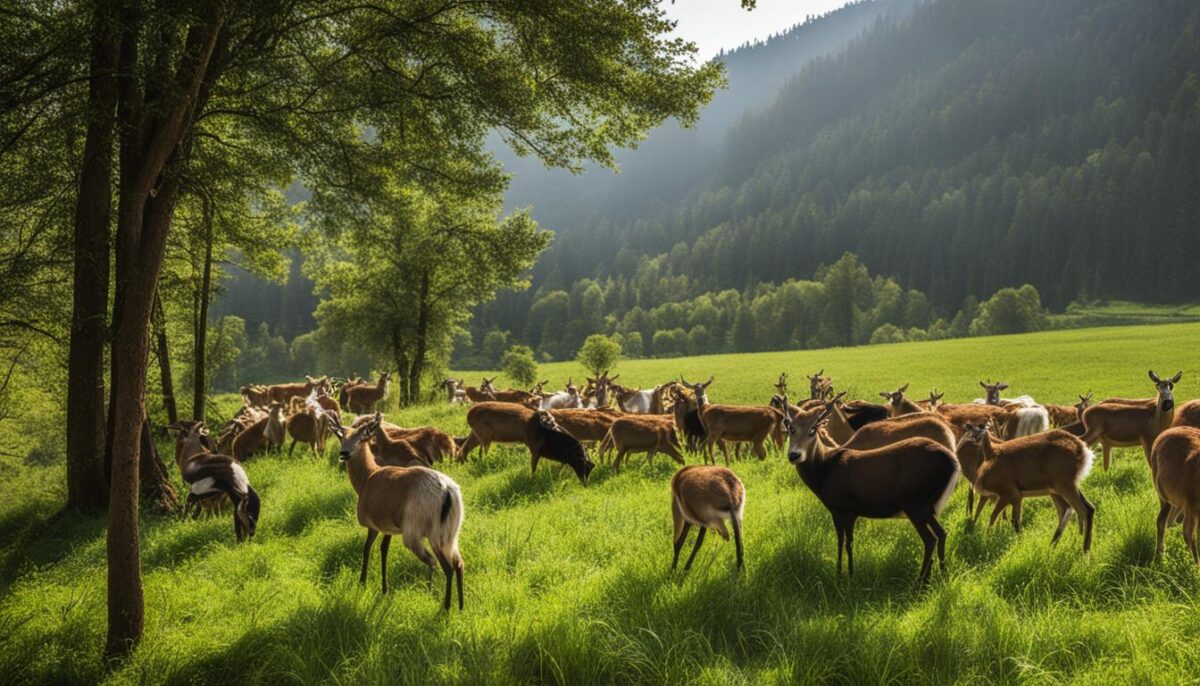
Deer and goats hold significant economic and agricultural importance, contributing to various industries and providing valuable resources for human consumption and utilization. Both deer farming and goat farming have their unique economic benefits and agricultural uses.
Deer Farming: Deer farming focuses primarily on hunting and game management. The economic importance of deer lies in their popularity among hunters and wildlife enthusiasts. Deer farms provide opportunities for recreational hunting, generating revenue from hunting licenses, guided hunts, and lodging. Additionally, deer meat is a sought-after delicacy, with venison being a high-value product in the culinary industry. Some deer farms also breed deer for trophy antlers, which have significant commercial value for decorations and ornamental purposes.
Goat Farming: Goat farming is diverse and encompasses various agricultural uses. One of the primary agricultural benefits of goats is milk production. Goat milk is not only consumed directly but is also processed into cheese, yogurt, and other dairy products. Goats are also raised for meat, with goat meat being popular in many cuisines worldwide. Additionally, goats are a valuable source of fiber, producing high-quality mohair and cashmere. Goat grazing is utilized for vegetation management and weed control in both agricultural and natural settings, providing an eco-friendly alternative to chemical herbicides.
Facts About Economic Contribution:
- In the United States, deer hunting generates billions of dollars annually, supporting local economies and providing employment opportunities in rural areas.
- The venison industry contributes to the economy through meat processing, packaging, and distribution.
- Goat farming is a growing industry in many countries, including the United States, with demand for goat meat, milk, and fiber steadily increasing.
- Goat grazing is gaining recognition as an environmentally friendly and cost-effective method for land management in various ecosystems, reducing the need for chemical interventions.
“Deer farming and goat farming play crucial roles in supporting livelihoods, promoting sustainable agriculture, and meeting the demands of various industries. The economic and agricultural importance of deer and goats extends beyond their natural beauty and grace, making them valuable assets in our modern society.”
| Economic Importance | Agricultural Uses | |
|---|---|---|
| Deer Farming | Popular among hunters and wildlife enthusiasts | Hunting, venison production, trophy antlers |
| Goat Farming | Diverse agricultural uses and products | Milk production, meat production, fiber, vegetation management |
Environmental Impact and Conservation Considerations
Understanding the environmental impact of deer and goats is crucial for effective conservation efforts. While both species play a role in shaping ecosystems, their presence can have different consequences.
Deer have the potential to contribute positively to their surroundings by aiding seed dispersal and participating in vegetation management. However, when deer populations become too dense, they can cause habitat destruction through excessive browsing. This can lead to a decline in plant diversity and negatively impact other wildlife species that depend on the affected vegetation for food and shelter. It is vital to manage deer populations to maintain a healthy balance and prevent habitat degradation.
On the other hand, goats, when properly managed, can be beneficial for controlling invasive plant species and improving soil health. They are known for their ability to eat a wide range of vegetation, including many plants that are considered undesirable or harmful. By grazing on invasive plants, goats can help restore native habitats and promote the growth of desirable plant species. However, unmanaged goat populations can pose a threat to native flora and fauna, as they may outcompete or consume native vegetation.
“It is essential to strike a balance between preserving the ecological integrity of habitats and managing deer and goat populations to minimize their negative impacts on native biodiversity.” – Dr. Jane Anderson, Conservation Biologist
Conservation efforts for deer and goats focus on protecting their habitats, managing population sizes through regulated hunting or culling programs, and implementing strategies to reduce human-wildlife conflicts. Additionally, promoting sustainable farming practices and responsible land management can contribute to the coexistence of these species with human activities.
| Environmental Impact | Conservation Considerations | |
|---|---|---|
| Deer | Positive: Seed dispersal, vegetation management |
Manage populations, prevent habitat destruction |
| Goats | Positive: Control invasive species, improve soil health | Monitor population, prevent negative impacts on native flora and fauna |
Cultural Significance and Symbolism
The cultural significance of deer and goats is deeply rooted in folklore and mythology, spanning various cultures around the world. These majestic creatures have captured the human imagination and have become symbolic representations of certain qualities and beliefs.
In many cultures, deer are often associated with grace, beauty, and spirituality. They are revered for their elegance and gentle nature. The symbolism of deer reflects their role as messengers of higher powers and their embodiment of harmony between the natural and spiritual realms. In folklore and mythology, deer are often portrayed as guides, leading individuals on spiritual journeys or offering wisdom and protection.
On the other hand, goats have their own cultural significance and symbolism. They are often associated with fertility, abundance, and resourcefulness. Goats have been regarded as symbols of prosperity and plenty due to their ability to thrive in diverse environments and adapt to challenging conditions. In many ancient civilizations, goats were symbolically linked to gods and goddesses, representing their power and resilience.
The cultural significance of deer and goats reflects the profound connection between humans and the natural world. Through folklore, mythology, and symbolism, these creatures continue to inspire and remind us of the beauty and mysteries of nature.
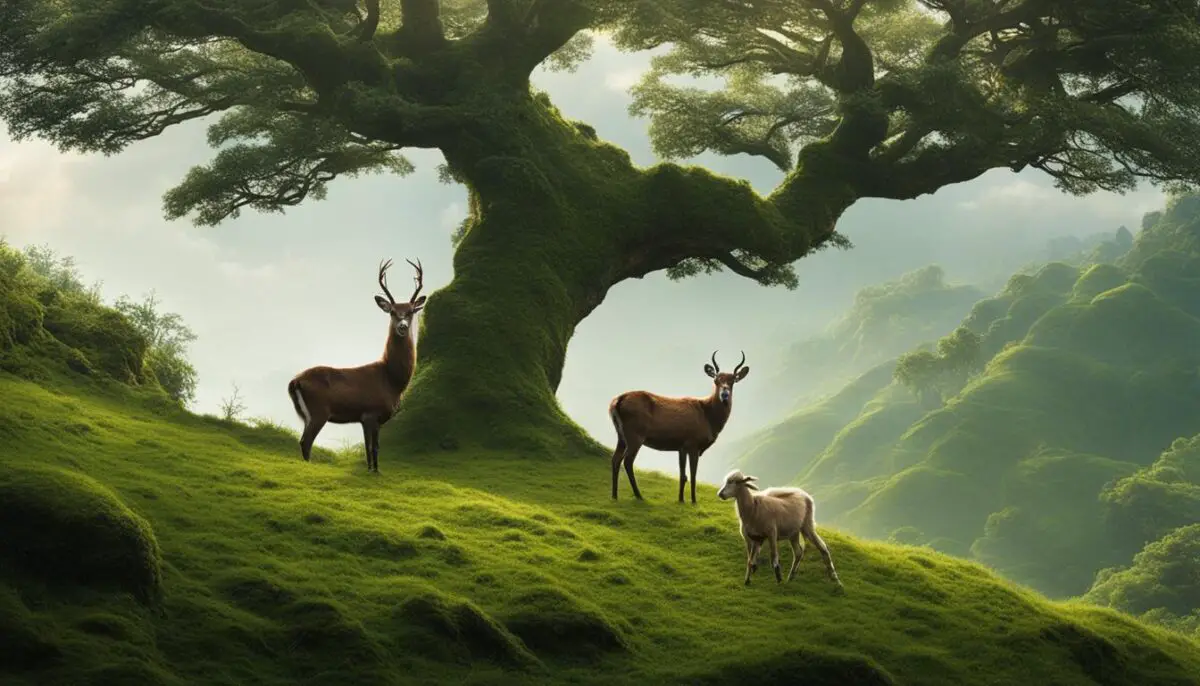
Conservation Efforts and Threats to Deer and Goats
Conservation efforts play a vital role in safeguarding the populations of both deer and goats. These magnificent creatures face various threats that require immediate attention and action. One of the primary concerns for deer populations is habitat loss. The destruction and fragmentation of their natural habitats due to human activities pose significant challenges. This loss of suitable habitat not only reduces their available resources but also increases the likelihood of human-wildlife conflict. It is crucial to implement measures to protect and restore their habitats to ensure their long-term survival.
Threats to goat populations also need to be addressed. Habitat loss, predation, and competition with domestic goats are some of the key factors affecting their populations. Certain wild goat species are particularly vulnerable to habitat destruction, further exacerbating their decline. Efforts must be made to conserve their habitats and minimize human disturbances to preserve their delicate ecological balance. Additionally, sustainable grazing practices and adequate management strategies can help mitigate the impact of domestic goats on the wild populations, ensuring their coexistence.
Hunting, both legal and illegal, poses another significant threat to both deer and goat populations. Uncontrolled hunting can lead to unsustainable population declines and disrupt the balance of ecosystems. By implementing sustainable hunting practices and enforcing regulations, we can better manage hunting activities and protect these species from overexploitation.
| Threats to Deer Populations | Threats to Goat Populations |
|---|---|
| Habitat loss and fragmentation | Habitat loss and degradation |
| Human-wildlife conflict | Predation |
| Unsustainable hunting | Competition with domestic goats |
“Conservation efforts are essential to protect the delicate balance of ecosystems and ensure the survival of both deer and goat populations. It is our responsibility to preserve their habitats, enforce sustainable practices, and raise awareness about the importance of these magnificent animals.”
Summary:
- Conservation efforts are crucial to protect deer and goat populations.
- Habitat loss and fragmentation pose significant threats to both species.
- Uncontrolled hunting can lead to unsustainable population declines.
- Predation, competition with domestic goats, and habitat degradation are additional threats to goat populations.
By addressing these threats and implementing effective conservation measures, we can ensure a sustainable future for both deer and goats, preserving their ecological roles and contributing to the overall biodiversity of our planet.
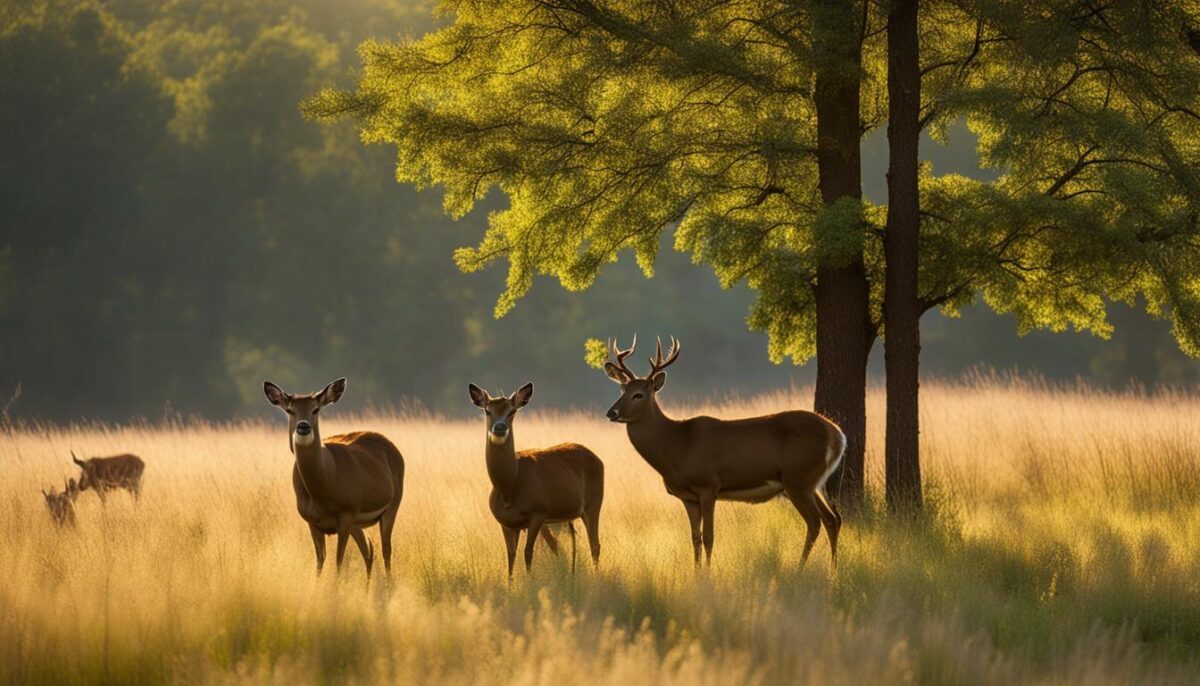
In conclusion, the future of deer and goat coexistence lies in our ability to manage wildlife populations and implement sustainable farming practices. By finding a balance between the needs of these animals and human activities, we can create an environment where both species can thrive. This requires continued research, collaboration between stakeholders, and a commitment to conservation efforts. As we navigate the challenges of coexistence, it is important to remember the vital role that deer and goats play in our ecosystems and the value they bring to our world.
Conclusion
After analyzing the differences and similarities between deer and goats, it is clear that these two creatures have unique traits that make them fascinating in their own ways. While both are herbivores and exhibit social behaviors, their diets, physical characteristics, and reproductive behaviors differ significantly.
Deer primarily consume grass, leaves, and shoots, while goats are browsers that eat a variety of vegetation, including leaves, twigs, and shrubs. Deer are typically larger than goats, with male deer growing antlers that are shed and regrown each year, while goats have permanent horns made of keratin.
Furthermore, deer and goats have distinct roles in ecosystems and human societies. Deer farming is focused on hunting and game management, while goat farming encompasses milk, meat, and fiber production. Both species face threats such as habitat loss and hunting, requiring conservation efforts to protect their populations and habitats.
Appreciating the unique qualities of both deer and goats contributes to our understanding of the natural world and the importance of conservation. The coexistence of these magnificent creatures can be achieved through effective wildlife management and sustainable farming practices, preserving their roles in ecosystems for generations to come.
FAQ
What do deer and goats eat?
Deer primarily consume grass, leaves, and shoots, while goats are browsers and eat a variety of vegetation, including leaves, twigs, and shrubs.
How do deer and goats differ in size and physical characteristics?
Deer are typically larger than goats, with an average height of 3-4 feet at the shoulder. Male deer have antlers that are shed and regrown annually, while goats have permanent horns made of keratin.
Do deer and goats have social behaviors and herds?
Yes, both deer and goats are social animals that form herds. Deer usually form small groups, especially during the mating season, while goats have a hierarchical social structure.
How do deer and goats reproduce and what are their offspring like?
Female deer give birth to a single fawn after a gestation period of 6-7 months. Female goats can give birth to multiple kids, usually 1-3, after a gestation period of about 5 months. Goat kids are known for their playful behavior and ability to walk shortly after birth.
What are the economic and agricultural uses of deer and goats?
Deer farming is primarily focused on hunting and game management, while goat farming includes milk, meat, and fiber production. Goats are also used for vegetation management and weed control.
What is the environmental impact of deer and goats?
Deer can have both positive and negative effects on ecosystems, contributing to seed dispersal but also causing excessive browsing and habitat destruction when overpopulated. Goats, when managed properly, can help control invasive plant species and improve soil health, but unmanaged populations can pose a threat to native flora and fauna.
What is the cultural significance and symbolism of deer and goats?
Deer are often associated with grace, beauty, and spirituality, while goats are associated with fertility, abundance, and resourcefulness. Both animals have symbolic importance in various cultures and mythologies.
What are the conservation efforts and threats to deer and goats?
Conservation efforts for deer and goats focus on protecting and restoring their habitats, implementing sustainable hunting practices, and raising awareness about their ecological importance. Threats include habitat loss, hunting, and competition with domestic goats.
How can deer and goats coexist with humans?
Coexistence requires effective wildlife management strategies and sustainable farming practices. This includes managing population sizes, preserving natural habitats, and promoting farming methods that minimize environmental impact.


